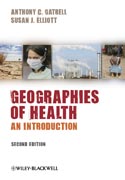
This substantially revised second edition highlights the ways in which healthmay be studied from geographical perspectives and reviews a wide range of studies linking health outcomes with social and physical environments. Addressingareas in need of particular attention, such as globalization, neighborhoods, contemporary health risks, and recent social health concerns (e.g. the obesityepidemic), the second edition provides an extensive revision of the original text and includes increased coverage of China, southeast Asia, and a greater emphasis on North America. INDICE: List of Figures.List of Tables.Figure Sources.Preface.Part I: Describing and Explaining Health in Geographical Settings:.1. Introducing Geographies of Health.Health and Geography: Some Fundamental Concepts.Concepts of health.Geographical concepts.Geographies of Health: Five Case Studies.Asthma in New York.Area effects on smoking in disadvantaged communities in Glasgow.The changing political economy of sex in South Africa.The personal significance of home.Embodied spaces of health and medical information on the Internet.Concluding Remarks.Further Reading.2. Explaining Geographies of Health.Positivist Approaches to the Geography of Health.Positivist explanation.Further examples of positivist approaches.Social Interactionist Approaches to the Geography of Health.Social interactionist explanation.Further examples of social interactionist approaches.Structuralist Approaches to the Geography of Health.Structuralist explanation.Further examples of structuralist or conflict-based approaches.Structurationist Approaches to the Geography of Health.Structurationist explanation.Further examples of structurationist approaches.Post-structuralist Approaches to the Geography of Health.Post-structuralist explanation.Further examples of post-structuralist approaches.Concluding Remarks.Further Reading.3. Method and Technique in the Geography of Health.Mapping the Geography of Health: Quantitative Approaches.Visualization.Exploratory spatial data analysis.Modeling health data in a spatial setting.Geographical information systems and health.Interpreting the Geography of Health: Qualitative Approaches.Interviews.Focus groups.Other qualitative methods.Qualitative data analysis.Rigor in qualitative research.Concluding Remarks.Further Reading.Part II: Health and the Social Environment:.4. Inequalities in Health Outcomes.Patterns of Inequality.Health inequalities: international comparisons.One Europe or many?.Health inequalities: regional and class divides.Explaining Inequalities in Health Outcomes.The programming hypothesis and the life course.Behavioral (lifestyle) factors.Social and community influences.Working conditions and local environments.Material deprivation and health.Concluding Remarks.Further Reading.5. Inequalities in the Provision and Utilization of Health Services.Principles of Health Service Delivery.Levels of health care provision.Geographies of rationing.Efficiency and equity.The need for health care.Inequalities in the Provision of Health Services.Health care provision in developing countries.Health care provision in the developed world.Utilization of Services.Use of primary health care services.Use of secondary and tertiary health care services.Do Provision and Utilization Affect Outcome?.Concluding Remarks.Further Reading.6. People on the Move: Migration and Health.Impact of Migration on Health.Migration and stress.The health of refugees.The impact of migration on the spread of disease.Migration and the incidence of disease and ill-health.Impact of Health Status on Migration.The selectivity of migration.Migration for health care and social support.The Relationship between Migration and the Delivery of Health Services.Concluding Remarks.Further Reading.Part III: Health and Human Modification of the Environment:.7. Air Quality and Health.Types of Pollutants.Area Sources.Radon.Ozone.LinearSources.Point Sources.Point sources in the developing world.Point sources in the developed world.Concluding Remarks.Further Reading.8. Water Quality and Health.Water-borne Diseases.Cholera.Schistosomiasis.Gastroenteritis.Water Hardness.Chemical Contamination of Drinking Water.Aluminium, fluoride and arsenic.Other Forms of Contamination.Hazardous waste sites.Concluding Remarks.Further Reading.9. Health Impacts of Global Environmental Change.Stratospheric Ozone Depletion.Ozone depletion and skin cancer.Other health impacts of ozone depletion.Global Climate Change.Direct effects: thermal stress.Indirect effects.Impactson infectious (especially insect-borne) disease.Other health effects of climate change.Health Effects of Other Global Environmental Change.Concluding Remarks.Further Reading.10. Conclusions: Emerging Themes in Geographies of Health.The Macro-scale: Health and the Global.The Meso-scale.The Micro-scale.References.Appendix: Web-based Resources for the Geographies of Health.Index
- ISBN: 978-1-4051-7576-0
- Editorial: BLACKWELL
- Encuadernacion: Cartoné
- Páginas: 304
- Fecha Publicación: 09/01/2009
- Nº Volúmenes: 1
- Idioma: Inglés
